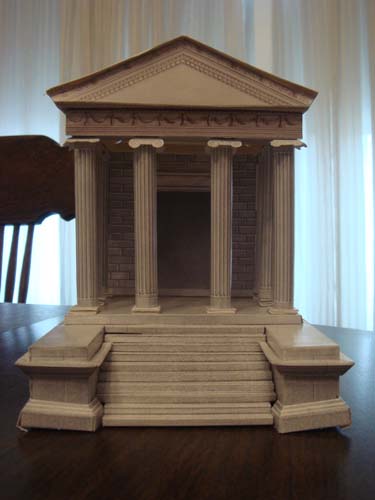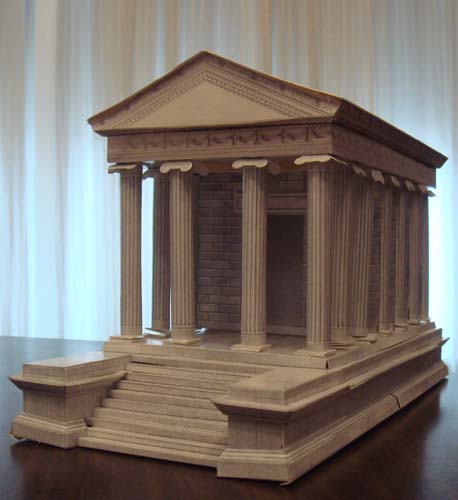 |
 |
Two views of the paper model of Temple
Fortuna Virile |
|
I just finished this simple kit today, November 26, 2007. I bought this kit and three others from Daedelus Books. Below is the text of the notes from the kit:
"A very busy trading centre existed in the Republican Age, on the left bank of the Tiber, reaching from just below the Tiberina Island to the slopes of the Campidoglio, at the junction of two main communications, that of the river and that of the north-south route between Etruria and Campania. A port, a fruit and vegetable market and the cattle market (from which comes the name "Foro Boario" given to the whole zone) made up this area. Next to these commercial structures also stood, at the foot of the Capitoline Hill, a number of places of worship, such as the two temples dedicated to the Mater Matuta and to the god Portuno, protector of the port. This sacred district in the Modern Age was <':alled "di Sant'Omobono", after the name of a small sixteenth-century church built there. The temple of Portunus, better known as the "Tempio della Fortuna Virile" or also, "del Velabro", was excavated and identified between the years 1925 and 1937, in the archaeological area close to Sant' Omobono and attributed according to tradition to the reign of Servius Tullius, Rome's King of Etruscan origin. In reality no precise attribution to this architecture is known, its date being roughly put between the 6th and the end of the 2nd century BC, in the late Republican Age, and perhaps up untill the government of Silla. The excellent state of conservation dates probably from rebuilding done in the 1st century BC. Today it stands on a narrow archaeological garden site behind the Aventino Tiber embankment and near the Palatine Bridge, facing via del Teatro di Marcello where it issues onto piazza Bocca della Verità.
"It is the best preserved example of a pseudoperipteran temple, a type of Graeco-Italian derivation that appeared in Rome towards the middle of the 2nd century Be. Orientated, that is with its two smaller sides different, in the ancient Italian manner, and in the Ionic order, it is composed of eighteen fluted columns nine metres high, with seven on either side and four on the main front.
"The wall facing half incorporates five columns per side, dividing the temple
in two distinct zones: the single-opening cella, and the pronaos two abutments
deep. Access to the latter is trough a built-in flight of steps, the temple
having been built upon a high podium, a solution of Etruscan derivation.
Its rectangular shape, 32 metres long and 16 wide, was originally below ground
and was only raised to the level of the ancient Roman road in 1830. The roof
is of the traditional two-pitched type, with tympana on the north and south
sides, resting on a tall trabeation.
The materials used in the construction are tufa and travertine, at one time,
which were originally plastered.
"There are several analogies with other architectural works of the period: the pseudoperipteran temple of Tivoli, from the mid-2nd century BC, compared to which the Roman one has an additional abutment in the pronaos, and the more interesting "Maison Carn~e" at Nimes, in a classical Roman corinthian order and dedicated to the grandchildren of Augustus. This temple dates from the 1st century BC, though it belongs to a more complex architectural system of which it forms the fulcrum. The "Maison Carree" moreover is of such great harmony in its decoration, albeit within the canons of Roman architecture, that Stendhal in 1837 described it as "the smile of a habitually serious person".
"The fate of the Temple of the Fortuna Virile was, especially in recent centuries, bound up with that extraQrdinary capacity which only Rome possesses, of "transforming" its built material, of swallowing up and rendering its architecture in a scenic superimposition of functions and forms. In 872 one of Pope John VIII's officials, Stefano Stefaneschi, converted it into a church dedicated to Santa Maria Egiziaca, and completely closed its colonnade. The present Ponte Ratto, at the Tiberina Island, was also called Ponte di S. Maria in the Middle Ages, on account of its closeness to the new church.
"In a printing by the German painter J.H.W. Tischbein, who worked at the end of the eighteenth century, the little church is represented with a courtyard in front of it, delimited by a low wall, joined to the surrounding buildings on one side and to the south, whilst on the side facing the river it overlooks a. street whose backcloth is the church of Santa Maria in Cosmedin and which on the opposite side runs close to the Temple of Vesta. Among the works planned by the Cammissiane degli Abbellimenti, according to a decree dated 27 July 181 I signed by Napoleon and prepared by the prefect De Toumon, is the following item: " ... - excavations ... at the temples of Vesta and of the Fortuna Virile, in the Forum: completed or commenced together with works of reinforcement and restoration".
"Thus in the first decades of the 19th century the building was entirely brought back to light; and the rectangular plan can be seen, together with other remains discovered at the time, in a diagram on the margin of the map Rama Anno MDCCCXXVI, published by Angelo Uggeri, illustrating the monuments excavated and repaired by Pius VII.
"The outline of the little temple raised on its base, together with that of the circular colonnade of the Temple of Vesta dating from the same period, with the medieval facade and Romanesque bell-tower of Santa Maria in Cosmedin, (the church of the "Bocca della Verita"), and. the eighteenth¬century fountain with tritons by Carlo Bizzaccheri, composes the postcard of one of the piazzas most intimately associated with the iconography of Rome."
Send
email to Bob at electricbob@alephnaught.com
Send
email to Aviva at avivakramer@earthlink.net